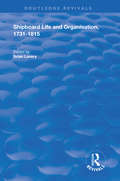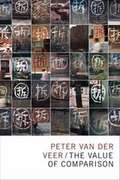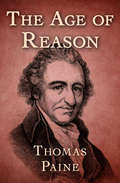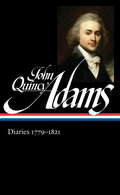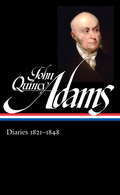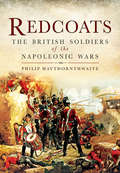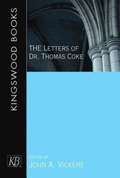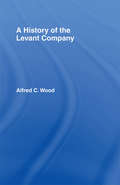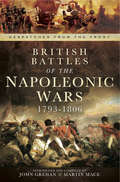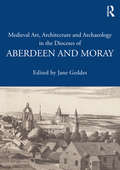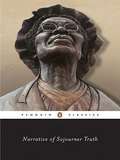- Table View
- List View
Shipboard Life and Organisation, 1731-1815 (Routledge Revivals)
by Brian LaveryFirst published in 1998, this volume explores the Royal Navy which had most of its greatest triumphs in the decades up to 1815, but has received relatively little study of its social life and shipboard administration, beyond popular myth and sensational accounts. This volume starts with the formal structure of naval discipline, with Admiralty instructions and captains' orderbooks. It then looks at how things really happened, using diaries, medical journals, petitions, court martial reports and even the menu book of a semi-literate steward. It reveals many strong characters and colourful incidents of shipboard life, while providing material for study.
The Value of Comparison
by Peter van der Veer Thomas GibsonIn The Value of Comparison Peter van der Veer makes a compelling case for using comparative approaches in the study of society and for the need to resist the simplified civilization narratives popular in public discourse and some social theory. He takes the quantitative social sciences and the broad social theories they rely on to task for their inability to question Western cultural presuppositions, demonstrating that anthropology's comparative approach provides a better means to understand societies. This capacity stems from anthropology's engagement with diversity, its fragmentary approach to studying social life, and its ability to translate difference between cultures. Through essays on topics as varied as iconoclasm, urban poverty, Muslim immigration, and social exclusion van der Veer highlights the ways that studying the particular and the unique allows for gaining a deeper knowledge of the whole without resorting to simple generalizations that elide and marginalize difference.
The Age of Reason: Being An Investigation Of True And Fabulous Theology - Primary Source Edition
by Thomas PaineThe author of Rights of Man and Common Sense argues for belief in God without religion.My own mind is my own church. In The Age of Reason, political activist and Founding Father Thomas Paine makes a powerful case for a rational approach to theology. In keeping with the intellectual tradition of British Deism, Paine rejects the notion of divine revelation, saying &“it is revelation to the first person only, and hearsay to every other.&” He proceeds with a detailed analysis of the Bible&’s inconsistencies and historical inaccuracies to conclude that it cannot be a divinely inspired text. Arguing against all forms of organized religion, he declares nature itself to be the only true testament to the existence of a divine creator. Originally published in three parts, in 1794, 1795, and 1807, The Age of Reason was a major influence on the freethinker movement in the United States. In Britain, however, it was declared seditious and led to the arrest of those who dared to print and distribute it. This ebook has been professionally proofread to ensure accuracy and readability on all devices.
Bright Star
by John KeatsJOHN KEATS edited with an introduction by Miriam Chalk This book gathers the most potent passages from Keats together, including the famous 'Odes', the sonnets, the luxuriously sensuous 'Eve of St Agnes', the mysterious and atmospheric 'La Belle Dame Sans Merci', and extracts from 'Lamia', Endymion and Hyperion. British Poets Series. Bibliography and notes. John Keats is one of the few British poets who is truly ecstatic and wild. Despite the overly-ornate language, the often awkward phrases ('made sweet moan' in 'La Belle Dame Sans Merci'), despite the Romantic indulgences and the sometimes sexist views, the often over-simplification of natural and human processes and experiences, and despite the tendency to gush and exaggerate, Keats is one of the few poets who write in English who is truly wild and shamanic. He is the British poet closest to the pure intoxication of Arthur Rimbaud. Keats reaches the pinnacle of British poetry, as W. Jackson Bate, typical among critics, says: 'the language of his greatest poetry has always held an attraction; for there we reach, if only for a brief while, a high plateau where in mastery of phrase he has few equals in English poetry, and only one obvious superior. '
Human Dignity, Human Rights, and Responsibility
by Yechiel Michael Barilan"Human dignity" has been enshrined in international agreements and national constitutions as a fundamental human right. The World Medical Association calls on physicians to respect human dignity and to discharge their duties with dignity. And yet human dignity is a term--like love, hope, and justice--that is intuitively grasped but never clearly defined. Some ethicists and bioethicists dismiss it; other thinkers point to its use in the service of particular ideologies. In this book, Michael Barilan offers an urgently needed, nonideological, and thorough conceptual clarification of human dignity and human rights, relating these ideas to current issues in ethics, law, and bioethics. Combining social history, history of ideas, moral theology, applied ethics, and political theory, Barilan tells the story of human dignity as a background moral ethos to human rights. After setting the problem in its scholarly context, he offers a hermeneutics of the formative texts on Imago Dei; provides a philosophical explication of the value of human dignity and of vulnerability; presents a comprehensive theory of human rights from a natural, humanist perspective; explores issues of moral status; and examines the value of responsibility as a link between virtue ethics and human dignity and rights. Barilan accompanies his theoretical claim with numerous practical illustrations, linking his theory to such issues in bioethics as end-of-life care, cloning, abortion, torture, treatment of the mentally incapacitated, the right to health care, the human organ market, disability and notions of difference, and privacy, highlighting many relevant legal aspects in constitutional and humanitarian law.
John Quincy Adams: Diaries 1779-1821 (Library of America Adams Family Collection #5)
by John Quincy AdamsA landmark edition of an American masterpiece: the incomparable self-portrait of John Quincy Adams and his times from the Revolution to the coming of the Civil WarThe diary of John Quincy Adams is one of the most extraordinary works in American literature. Begun in 1779 at the age of twelve and kept more or less faithfully until his death almost 70 years later, and totaling some fifteen thousand closely-written manuscript pages, it is both an unrivaled record of historical events and personalities from the nation's founding to the antebellum era and a masterpiece of American self-portraiture, tracing the spiritual, literary, and scientific interests of an exceptionally lively mind. Now, for the 250th anniversary of Adams's birth, Library of America and historian David Waldstreicher present a two-volume reader's edition of diary selections based for the first time on the original manuscripts, restoring personal and revealing passages suppressed in earlier editions.Volume I begins during the American Revolution, with Adams's first entry, as he prepares to embark on a perilous wartime voyage to Europe with his father, diplomat John Adams, and records his early impressions of Franklin and Jefferson and of Paris on the eve of revolution; it details his abbreviated but eventful years of study at Harvard and his emergence into the world of politics in his own right, as American minister to the Netherlands and to Prussia, and then as a U. S. senator from Massachusetts; and it reveals a young man at war with his passions, before finding love with the remarkable Louisa Catherine Johnson. In passages that form a kind of real-world War and Peace, the diary follows the young married couple to St. Petersburg, where as U.S. minister Adams is a witness to Napoleon's invasion of Russia. Its account of the negotiations at Ghent to end the War of 1812, where Adams leads the American delegation, is the perhaps the most detailed and dramatic picture of a diplomatic confrontation ever recorded. Volume 1 concludes with his elevation as Secretary of State under James Monroe, as he takes the fore in a fractious cabinet and emerges as the principal architect of what will become known as the Monroe Doctrine.
John Quincy Adams: Diaries 1821-1848 (Library of America Adams Family Collection #6)
by John Quincy AdamsA landmark new selected edition of an American masterpiece: the incomparable self-portrait of a man and his times from the Revolution to the coming of the Civil War The diary of John Quincy Adams is one of the most extraordinary works in American literature. Begun in 1779 at the age of twelve and kept more or less faithfully until his death almost 70 years later, and totaling some fifteen thousand closely-written manuscript pages, it is both an unrivaled record of historical events and personalities from the nation's founding to the antebellum era and a masterpiece of American self-portraiture, tracing the spiritual, literary, and scientific interests of an exceptionally lively mind. Now, for the 250th anniversary of Adams's birth, Library of America and historian David Waldstreicher present a two-volume reader's edition of diary selections based for the first time on the original manuscripts, restoring personal and revealing passages suppressed in earlier editions. Volume 2 opens with Adams serving as Secretary of State, amid political maneuverings within and outside James Monroe's cabinet to become his successor, a process that culminates in Adams's election to the presidency by the House of Representatives after the deadlocked four-way contest of 1824. Even as Adams takes the oath of office, rivals Henry Clay, his Secretary of State, John C. Calhoun, his vice president, and an embittered Andrew Jackson, eye the election of 1828. The diary records in candid detail his frustration as his far-sighted agenda for national improvement founders on the rocks of internecine political factionalism, conflict that results in his becoming only the second president, with his father, to fail to secure reelection. After a short-lived retirement, Adams returns to public service as a Congressman from Massachusetts, and for the last seventeen years of his life he leads efforts to resist the extension of slavery and to end the notorious "gag rule" that stifles debate on the issue in Congress. In 1841 he further burnishes his reputation as a scourge of the Slave Power by successfully defending African mutineers of the slave ship Amistad before the Supreme Court. The diary achieves perhaps its greatest force in its prescient anticipation of the Civil War and Emancipation, an &“object,&” as Adams described it during the Missouri Crisis, &“vast in its compass, awful in its prospects, sublime and beautiful in its issue.&”
Redcoats: The British Soldiers of the Napoleonic Wars
by Philip HaythornthwaiteWhat was a British soldiers life like during the Napoleonic Wars? How was he recruited and trained? How did he live on home service and during service abroad? And what was his experience of battle? In this landmark book Philip Haythornthwaite traces the career of a British soldier from enlistment, through the key stages of his path through the military system, including combat, all the way to his eventual discharge. His fascinating account shows how varied the recruits of the day were, from urban dwellers and weavers to plowboys and laborers, and they came from all regions of the British Isles including Ireland and Scotland. Some of them may have justified the Duke of Wellingtons famous description of them as the scum of the earth. Yet these common soldiers were capable of extraordinary feats on campaign and on the battlefield that eventually turned the course of the war against Napoleon.
The Letters of Dr. Thomas Coke
by John A. VickersFor forty years on either side of the death of John Wesley in 1791, Thomas Coke was a key figure in the development of Methodism on both sides of the Atlantic. His surviving correspondence is the most personal evidence he has left us of a man who “wore his heart on his sleeve.” Coke's letters also give us contemporary insight into some of the events which began the transformation of an evangelical movement into a worldwide communion of Churches. This critical edition gives a comparison to earlier editions, as well as references to names and locations for historical study.
A History of the Levant Company
by Alfred C. WoodFirst Published in 1964. Routledge is an imprint of Taylor & Francis, an informa company.
British Battles of the Napoleonic Wars, 1793–1806: Despatched From The Front (Despatches from the Front #1)
by Martin MaceThe Napoleonic Wars was truly a world-wide conflict and Britain found itself engaged in battles, sieges and amphibious operations around the globe. Following every battle the commanding officer submitted a report back to the Admiralty or the War Office. Presented here together for the first time are those original despatches from some forty generals, captains and admirals detailing more than eighty battles that took place in India, Africa, Europe and the Americas. This unique collection of original documents will prove to be an invaluable resource for historians, students and all those interested in what was one of the most important periods in British military and naval history.The reports include those from some of Britain's most famous battles, the likes of Trafalgar and Waterloo, as well as less well-known but just as important engagements which resulted in the capture of the islands and territories which helped form the greatest empire the world has ever known.
The First American Cookbook: A Facsimile of "American Cookery," 1796
by Amelia SimmonsThis facsimile of the first American-written cookbook published in the United States is not only a first in cookbook literature, but a historic document. It reveals the rich variety of food Colonial Americans enjoyed, their tastes, cooking and eating habits, even their colorful language.Author Amelia Simmons worked as a domestic in Colonial America and gathered her cookery expertise from firsthand experience. Her book points out the best ways of judging the quality of meats, poultry, fish, vegetables, etc., and presents the best methods of preparing and cooking them. In choosing fish, poultry, and other meats, the author wisely advises, "their smell denotes their goodness." Her sound suggestions for choosing the freshest and most tender onions, potatoes, parsnips, carrots, asparagus, lettuce, cabbage, beans, and other vegetables are as timely today as they were nearly 200 years ago.Here are the first uniquely American recipes using corn meal -- Indian pudding, "Johnny cake," and Indian slapjacks -- as well as the first recipes for pumpkin pudding, winter squash pudding, and for brewing spruce beer. The words "cookie" and "slaw" made their first published appearance in this book. You'll also find the first recommended use of pearlash (the forerunner of baking powder) to lighten dough, as well as recommendations for seasoning stuffing and roasting beef, mutton, veal, and lamb -- even how to dress a turtle.Along with authentic recipes for colonial favorites, a Glossary includes definitions of antiquated cooking terms: pannikin, wallop, frumenty, emptins, and more. And Mary Tolford Wilson's informative Introductory Essay provides the culinary historical background needed to appreciate this important book fully.Anyone who uses and collects cookbooks will want to have The First American Cookbook. Cultural historians, Americana buffs, and gourmets will find this rare edition filled with interesting recipes and rich in early American flavor.
Medieval Art, Architecture and Archaeology in the Dioceses of Aberdeen and Moray (The British Archaeological Association Conference Transactions)
by Jane GeddesExploring the medieval heritage of Aberdeenshire and Moray, the essays in this volume contain insights and recent work presented at the British Archaeological Association Conference of 2014, based at Aberdeen University. The opening, historical chapters establish the political, economic and administrative context of the region, looking at both the secular and religious worlds and include an examination of Elgin Cathedral and the bishops’ palaces. The discoveries at the excavations of the kirk of St Nicholas, which have revealed the early origins of religious life in Aberdeen city, are summarized and subsequent papers consider the role of patronage. Patronage is explored in terms of architecture, the dramas of the Reformation and its aftermath highlighted through essentially humble parish churches, assailed by turbulent events and personalities. The collegiate church at Cullen, particularly its tomb sculpture, provides an unusually detailed view of the spiritual and dynastic needs of its patrons. The decoration of spectacular ceilings, both carved and painted, at St Machar’s Cathedral, Provost Skene’s House and Crathes Castle, are surveyed through the eyes of their patrons and the viewers below. Saints and religious devotion feature in the last four chapters, focusing on the carved wooden panels from Fetteresso, which display both piety and a rare glimpse of Scottish medieval carnal humour, the illuminated manuscripts from Arbuthnott, the Aberdeen Breviary and Historia Gentis Scotorum. The medieval artistic culture of north-east Scotland is both battered by time and relatively little known. With discerning interpretation, this volume shows that much high-quality material still survives, while the lavish illustrations restore some glamour to this lost medieval world.
Narrative of Sojourner Truth
by Sojourner TruthA symbol of the strength of African-American women, and a champion of the rights of all women, Sojourner Truth was an illiterate former slave in New York State who transformed herself into a vastly powerful orator. Dictating to a neighbor, she began her celebrated life story, in which she chronicles her youth, her 1827 emancipation, and her religious experiences, one year after the extremely successful publication in 1846 of Frederick Douglass's narrative. Truth's magnetism as an abolitionist speaker brought her fame in her own time, and her narrative gives today's readers a vivid picture of nineteenth-century life in the north, where blacks, enslaved or free, lived in relative isolation from one another. Based on the 1884 edition of the Narrative, this volume contains Book of Life, a contemporary collection of letters and biographical sketches about Truth's public appearances, including the controversial Arn't I a Woman speech and Harriet Beecher Stowe's 1863 essay, Sojourner Truth, The Libyan Sibyl as well as A Memorial Chapter about her death.
The Annotated Northanger Abbey
by Jane Austen David M. ShapardFrom the editor of the popular Annotated Pride and Prejudice comes an annotated edition of Jane Austen's Northanger Abbey that makes her lighthearted satire of the gothic novel an even more satisfying read. Here is the complete text of the novel with more than 1,200 annotations on facing pages, including: -Explanations of historical context-Citations from Austen's life, letters, and other writings-Definitions and clarifications-Literary comments and analysis-Maps of places in the novel-An introduction, bibliography, and detailed chronology of events-225 informative illustrations Filled with fascinating details about the characters' clothing, furniture, and carriages, and illuminating background information on everything from the vogue for all things medieval to the opportunities for socializing in the popular resort town of Bath, David M. Shapard's Annotated Northanger Abbey brings Austen's world into richer focus.
The Everything American History Book: People, Places, and Events That Shaped Our Nation
by John R McgeehanStarting with the first Viking explorations and continuing to the present day, The Everything American History Book, 2nd Edition takes you on a thrilling tour through history. It's packed with facts and vivid details of events that shaped the United States, including:Wars, battles, and famous generalsOutstanding American inventions--from the cotton gin to the InternetKey political figures--presidents, peacekeepers, visionariesAnd much, much more!The Everything American History Book, 2nd Edition covers all the major incidents and key players--from the Boston Tea Party to 9/11, and Lewis and Clark to Martin Luther King, Jr. This extraordinary retelling makes learning history fun for the whole family.
A Historical Dictionary of British Women
by Cathy HartleyThis reference book, containing the biographies of more than 1,100 notable British women from Boudicca to Barbara Castle, is an absorbing record of female achievement spanning some 2,000 years of British life.Most of the lives included are those of women whose work took them in some way before the public and who therefore played a direct and important role in broadening the horizons of women. Also included are women who influenced events in a more indirect way: the wives of kings and politicians, mistresses, ladies in waiting and society hostesses.Originally published as The Europa Biographical Dictionary of British Women, this newly re-worked edition includes key figures who have died in the last 20 years, such as The Queen Mother, Baroness Ryder of Warsaw, Elizabeth Jennings and Christina Foyle.
The Virgin in the Garden
by A. S. ByattThe Virgin in the Garden is a wonderfully erudite entertainment in which enlightenment and sexuality, Elizabethan drama and contemporary comedy, intersect richly and unpredictably.
Coleridge as Philosopher (Muirhead Library Of Philosophy Ser.)
by Muirhead, John HFirst published in 2002. Routledge is an imprint of Taylor & Francis, an informa company.
Edgar Huntly Or, Memoirs of a Sleep - Walker
by Charles Brockden BrownThe ensuing day was spent, partly in sleep, and partly in languor and disquietude. I incessantly ruminated on the incidents of the last night. The scheme that I had formed was defeated. Was it likely that this unknown person would repeat his midnight visits to the Elm? If he did, and could again be discovered, should I resolve to undertake a new pursuit, which might terminate abortively, or in some signal disaster? But what proof had I that the same rout would be taken, and that he would again inter himself alive in the same spot?
Nunca es demasiado pronto para decir te quiero
by Antonio SánchezAna te hará reír en su viaje a la sierra. Aunque en su viaje interior se ve obligada a tomar decisiones que no serán sencillas... Ana, divorciada con hijos, se siente sola y estresada en una vida en la que no tiene ni un minuto para respirar. Cuando el padre de los niños se los lleva una semana de vacaciones ella no duda en plantearse hacer un viaje sola a la sierra. Para descansar, para relajarse, para dormir. Pero en unas circunstancias extrañas conoce a un extravagante fotógrafo de naturaleza que le hace una proposición inesperada. A partir de ahí el viaje solitario se transforma para convertirse en una aventura por completo distinta a lo que había planeado. Amena, divertida, ágil y repleta de emociones. Con unos personajes entrañables y cercanos, brutalmente cercanos, que coinciden en uno de los lugares más hermosos de España.
The Spy: A Tale Of The Neutral Ground
by James Fenimore CooperJames Fenimore Cooper (1789-1851) hints that his second novel, The Spy, was inspired by the exploits of an unnamed Revolutionary Era agent. The Spy was the first American novel to achieve a wide circulation. Given the small population of the country in 1821, few books since have achieved such a proportional success.
All That Consumes Us
by Erica WatersAll That Consumes Us has descriptive copy which is not yet available from the Publisher.
America Afire: Jefferson, Adams, and the First Contested Election
by Bernard A. WeisbergerAmerica Afire is the powerful story of the election of 1800, arguably the most important election in America's history and certainly one of the most hotly disputed. Former allies Adams and Jefferson, president versus vice president, Federalist versus Republican, squared off in a vicious contest that resulted in broken friendships, scandals, riots, slander, and jailings in the fourth presidential election under the Constitution.
Barrier-Free Design
by James Holmes-SeidleThis book for architects, interior designers, building managers, students, conference organisers looks at first principles to provide the user with the 'tools' to make their own decisions rather than a 'cookbook' approach. It is intended that designs and product information can be taken straight from the manual and inserted into ongoing projects. For the first time the book considers the needs of people with visual, hearing and mental disabilities, who make up the majority of disabled people in the population, alongside those of people with physical mobility disabilities. Practical low cost solutions to retro-fitting existing buildings are discussed, as well as the methods used to assess the suitability of an existing building, and assembling a project to improve access for disabled people. Specific products and designs are illustrated and discussed - with full working technical drawings, and full specification details. These will reduce considerably the research time needed to produce a cost-effective solution that will improve access for disabled people. A perspective of the standards and legislation dealing with access issues in the UK is compared with those in other countries, and the standards mentioned are compared with the realities of practical implementation carried out in 4 years of design in this area.
